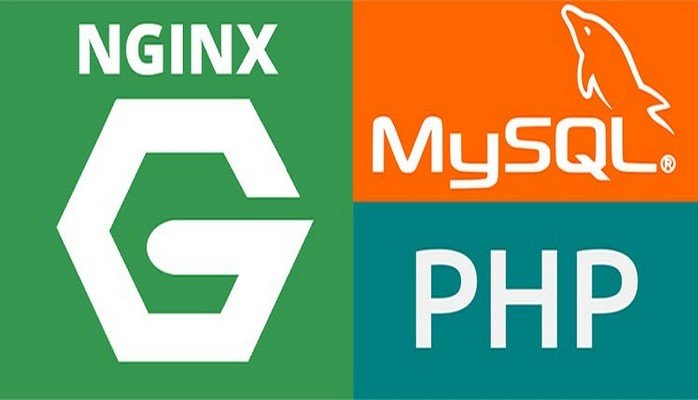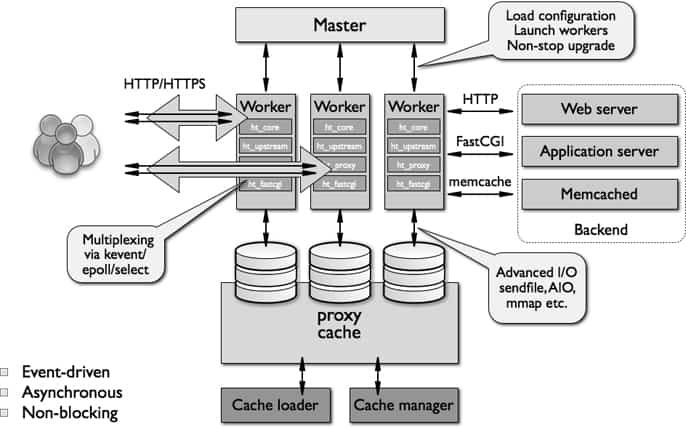
NGINX was created to meet C10K challenges handling at least 10000 concurrent connections on an unique server. NGINX uses an asynchronous event-driven architecture to handle these huge number of connections. This architecture makes high processing and load fluctuation more predictable about RAM usage, CPU usage, and latency.

In this article, I will guide you how to install the famous LEMP webserver including: Linux + Nginx + MariaDB + PHP (PHP-FPM) on CentOS 7/6.5/6.4/6.3/6.2/6.1/6/5.10.
– Nginx (read Engine x) is a small, less RAM-intensive, powerful and high-performance webserver.
– PHP supports versions 5.3, 5.4, 5.5, 5.6, 7.0
– MariaDB is open source version of MySQL, operates identically to MySQL. Starting from CentOS 7, by default, started to support MariaDB, you should use it instead of MySQL now.
I. Install Nginx and PHP on CentOS 7/6.5/5.10
Firstly, you need to prepare a new Centos server with installing nothing. Check that the hostname and host file are correct before starting.
The operations are done with the command line, use ZOC Terminal and nano tool.
- Add needed repo
CentOS 7/6.5/5.10 EPEL repository
yum install epel-release
CentOS 7/6.5/5.10 Remi repository
## CentOS 7 ##
rpm -Uvh http://rpms.famillecollet.com/enterprise/remi-release-7.rpm
## CentOS 6 ##
rpm -Uvh http://rpms.famillecollet.com/enterprise/remi-release-6.rpm
## CentOS 5 ##
rpm -Uvh http://rpms.famillecollet.com/enterprise/remi-release-5.rpm
CentOS 7/6.5/5.10 Nginx repository
## CentOS 7 ##
rpm -Uvh http://nginx.org/packages/centos/7/noarch/RPMS/nginx-release-centos-7-0.el7.ngx.noarch.rpm
## CentOS 6 ##
rpm -Uvh http://nginx.org/packages/centos/6/noarch/RPMS/nginx-release-centos-6-0.el6.ngx.noarch.rpm
## CentOS 5 ##
rpm -Uvh http://nginx.org/packages/centos/5/noarch/RPMS/nginx-release-centos-5-0.el5.ngx.noarch.rpm
- Install Nginx, PHP
CentOS 7/6.5/5.10
## PHP 5.3 ##
yum install -y nginx php-fpm php-common
## PHP 5.4 ##
yum –enablerepo=remi install -y nginx php-fpm php-common
## PHP 5.5 ##
yum –enablerepo=remi,remi-php55 install -y nginx php-fpm php-common
## PHP 5.6 ##
yum –enablerepo=remi,remi-php56 install -y nginx php-fpm php-common
## PHP 7.0 ##
yum –enablerepo=remi,remi-php70 install -y nginx php-fpm php-common
## PHP 7.1 ##
yum –enablerepo=remi,remi-php71 install -y nginx php-fpm php-common
- Install module PHP
Some common module PHPs:
- OPcache (php-opcache) – The Zend OPcache provides faster PHP execution through opcode caching and optimization.
- APCu (php-pecl-apc) – APCu userland caching
- CLI (php-cli) – Command-line interface for PHP
- PEAR (php-pear) – PHP Extension and Application Repository framework
- PDO (php-pdo) – A database access abstraction module for PHP applications
- MySQL (php-mysqlnd) – A module for PHP applications that use MySQL databases
- PostgreSQL (php-pgsql) – A PostgreSQL database module for PHP
- MongoDB (php-pecl-mongo) – PHP MongoDB database driver
- SQLite (php-pecl-sqlite) – Extension for the SQLite Embeddable SQL Database Engine
- Memcache (php-pecl-memcache) – Extension to work with the Memcached caching daemon
- Memcached (php-pecl-memcached) – Extension to work with the Memcached caching daemon
- GD (php-gd) – A module for PHP applications for using the gd graphics library
- XML (php-xml) – A module for PHP applications which use XML
- MBString (php-mbstring) – A module for PHP applications which need multi-byte string handling
- MCrypt (php-mcrypt) – Standard PHP module provides mcrypt library support
To install, you use command yum –enablerepo=remi,remi-php56 install ten_module.
For example:
yum –enablerepo=remi,remi-php56 install -y php-opcache php-pecl-apcu php-cli php-pear php-pdo php-mysqlnd php-pgsql php-pecl-mongo php-pecl-sqlite php-pecl-memcache php-pecl-memcached php-gd php-mbstring php-mcrypt php-xml
- Stop httpd (Apache) server, Start Nginx and PHP-FPM
Stop httpd (Apache)
## CentOS 7 ##
systemctl stop httpd.service
## CentOS 6.5/5.10 ##
service httpd stop
Start Nginx
## CentOS 7 ##
systemctl start nginx.service
## CentOS 6.5/5.10 ##
service nginx start
Start PHP-FPM
## CentOS 7 ##
systemctl start php-fpm.service
## CentOS 6.5/5.10 ##
service php-fpm start
- Auto start Nginx, PHP-FPM and turn off httpd
Turn off httpd (Apache) when boot
## CentOS 7 ##
systemctl disable httpd.service
## CentOS 6.5/5.10 ##
chkconfig httpd off
Autostart Nginx
## CentOS 7 ##
systemctl enable nginx.service
## CentOS 6.5/5.10 ##
chkconfig –add nginx
chkconfig –levels 235 nginx on
Autostart PHP-FPM
## CentOS 7 ##
systemctl enable php-fpm.service
## CentOS 6.5/5.10 ##
chkconfig –add php-fpm
chkconfig –levels 235 php-fpm on
- Nginx and PHP-FPM Configuration
Nginx Configuration
– Change worker_processes
nano /etc/nginx/nginx.conf
Edit worker_processes to equal your VPS processor
– Nginx virtual hosts configuration
nano /etc/nginx/conf.d/default.conf
You change the information as below:
#
# The default server
#
server {
listen 80 default_server;
server_name example.com;
location / {
root /usr/share/nginx/html;
index index.php index.html index.htm;
try_files $uri $uri/ /index.php?q=$uri&$args;
}
error_page 404 /404.html;
location = /404.html {
root /usr/share/nginx/html;
}
error_page 500 502 503 504 /50x.html;
location = /50x.html {
root /usr/share/nginx/html;
}
# pass the PHP scripts to FastCGI server listening on 127.0.0.1:9000
#
location ~ \.php$ {
root /usr/share/nginx/html;
fastcgi_pass 127.0.0.1:9000;
fastcgi_index index.php;
fastcgi_param SCRIPT_FILENAME $document_root$fastcgi_script_name;
include fastcgi_params;
}
}
The paragraph highlighted in red font is necessary to change.
– Restart Nginx
## CentOS 7 ##
systemctl restart nginx.service
## CentOS 6.5/5.10 ##
service nginx restart
PHP-FPM Configuration
– Edit user and group
nano /etc/php-fpm.d/www.conf
Change user and group = apecha to nginx
[…]
; Unix user/group of processes
; Note: The user is mandatory. If the group is not set, the default user’s group
; will be used.
; RPM: apache Choosed to be able to access some dir as httpd
user = nginx
; RPM: Keep a group allowed to write in log dir.
group = nginx
[…]
– Restart PHP-FPM
## CentOS 7 ##
systemctl restart php-fpm.service
## CentOS 6.5/5.10 ##
service php-fpm restart
- Test Nginx and PHP-FPM configuration
nano /usr/share/nginx/html/info.php
Add the next paragraph
<?php
phpinfo();
?>
Test with link: http://<ip-address>/info.php. If you find information out, you installed successfully.
Note: If you access directly IP with announcing error about no connection, open port http:
service iptables start
iptables -I INPUT -p tcp –dport 80 -j ACCEPT
service iptables save
service iptables restart
II. Install MariaDB on CentOS 7/6.5/5.10
1. Add repo MariaDB
Note: Noneed to carry out on CentOS 7. Now MariaDB version on CentOS 7 is 5.5.37
## CentOS 6/5 MariaDB 5.5 ##
wget -O /etc/yum.repos.d/MariaDB.repo http://mariadb.if-not-true-then-false.com/centos/$(rpm -E %centos)/$(uname -i)/5
## CentOS 6/5 MariaDB 10.0 ##
wget -O /etc/yum.repos.d/MariaDB.repo http://mariadb.if-not-true-then-false.com/centos/$(rpm -E %centos)/$(uname -i)/10
2. Install or update MariaDB
## CentOS 7 ##
yum install -y mariadb mariadb-server
## CentOS 6.5/5.10 ##
yum install -y MariaDB MariaDB-server
3. Start MariaDB and auto run when boot
## CentOS 7 ##
systemctl start mariadb.service
systemctl enable mariadb.service
## CentOS 6.5/5.10 ##
service mysql start
chkconfig –levels 235 mysql on
4. MariaDB configuration
- Set (Change) root password
- Remove anonymous users
- Disallow root login remotely
- Remove test database and access to it
- Reload privilege tables
– Start to install
/usr/bin/mysql_secure_installation
Even in the first step, you will be asked password root, installed just now so of course there is no password, click Enter to continue.
– Similar Output like:
NOTE: RUNNING ALL PARTS OF THIS SCRIPT IS RECOMMENDED FOR ALL MariaDB
SERVERS IN PRODUCTION USE! PLEASE READ EACH STEP CAREFULLY!
In order to log into MariaDB to secure it, we\’ll need the current
password for the root user. If you\’ve just installed MariaDB, and
you haven\’t set the root password yet, the password will be blank,
so you should just press enter here.
Enter current password for root (enter for none):
OK, successfully used password, moving on…
Setting the root password ensures that nobody can log into the MariaDB
root user without the proper authorisation.
Set root password? [Y/n] y
New password:
Re-enter new password:
Password updated successfully!
Reloading privilege tables..
… Success!
By default, a MariaDB installation has an anonymous user, allowing anyone
to log into MariaDB without having to have a user account created for
them. This is intended only for testing, and to make the installation
go a bit smoother. You should remove them before moving into a
production environment.
Remove anonymous users? [Y/n] y
… Success!
Normally, root should only be allowed to connect from \’localhost\’. This
ensures that someone cannot guess at the root password from the network.
Disallow root login remotely? [Y/n] y
… Success!
By default, MariaDB comes with a database named \’test\’ that anyone can
access. This is also intended only for testing, and should be removed
before moving into a production environment.
Remove test database and access to it? [Y/n] y
– Dropping test database…
… Success!
– Removing privileges on test database…
… Success!
Reloading the privilege tables will ensure that all changes made so far
will take effect immediately.
Reload privilege tables now? [Y/n] y
… Success!
Cleaning up…
All done! If you\’ve completed all of the above steps, your MariaDB
installation should now be secure.
Thanks for using MariaDB!
See more operations on database.
So you finished installing stack LEMP on CentOS.






![[WHAT IS CRONTAB?] – How to use CronTab Linux](https://linuxgpoint.com/wp-content/uploads/2019/04/how-to-crontab1.jpg)